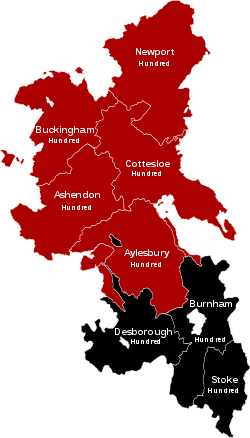Chiltern Hundreds
The Chiltern Hundreds in Buckinghamshire comprise three hundreds lying partially within the Chiltern Hills. "Taking the Chiltern Hundreds" now refers to the legal procedure used to effect resignation from the British House of Commons. This is because the ancient office of Crown Steward for the area (in full Crown Steward and Bailiff of the three Chiltern Hundreds of Stoke, Desborough and Burnham), having been reduced to a mere sinecure by the 17th century, became the first to be used in this resignation procedure a century later. Other titles were also later used for the same purpose, but at present only the Chiltern Hundreds office and the Crown Steward and Bailiff of the Manor of Northstead are used.
Contents
The three Chiltern Hundreds
The three Chiltern Hundreds are Stoke Hundred, Desborough Hundred, and Burnham Hundred. Despite their collective name only Desborough Hundred is located within the area defined by the Chiltern Hills in Buckinghamshire. The area had been Crown property as early as the 13th century.[1]
Steward and Bailiff
Original role
Through the Saxon and early Norman periods the area was administered by an elder. But by the late Middle Ages the office holder was elected from among a hundred's notable landholding families. As the area was wild and notorious for outlaws, a Steward and Bailiff was appointed directly by the Crown (thus as a royal bailiwick it was a legal office answerable to the reigning monarch) to maintain law and order. However, by the end of the 16th century such positions had been deprecated by changes in local and Crown representations and roles - the government of Elizabeth I had established royal representatives (Justices of the Peace, Sheriffs, and Lords Lieutenant) in every county of England and Wales; they ensured that Royal commands and laws were obeyed. By the 17th century the office of steward and bailiff was reduced to just a title with no attached powers or duties.[1]
Present use
In the 17th century Members of Parliament (MPs) were often elected against their will. On 2 March 1624, a resolution was passed by the House of Commons making it illegal for an MP to quit or wilfully give up his seat. However, under the constitutional Act, the Act of Settlement of 1701, and subsequent legislation, any Member of Parliament accepting an office of profit under the Crown is disqualified from his or her seat. This became the basis for the current legal practice of using sinecure posts such as this to effect resignations.
As it was still nominally a Crown office, the post of Crown Steward and Bailiff of the three Chiltern Hundreds of Stoke, Desborough and Burnham became the first title to be used in the procedure developed in the 18th century for resignation from the British House of Commons by MPs. While no longer having any actual role or responsibility, it is a nominal office for profit under the Crown: holding such an office disqualifies an MP from the House, as noted above. The Chiltern Hundreds office was the first to be officially used as a procedural device in this way, on 25 January 1751, to allow John Pitt, one of the two MPs for the constituency of Wareham, to resign. Between 1756 and 1799, 11 MPs also left Parliament by accepting the Stewardship of the Manor of Old Shoreham. The Steward of the Manor of Hempholme was an alternative from 1845 to 1865. A number of other offices have also been used in the same way at one time or another.
References
- ↑ 1.0 1.1 "The Chiltern Hundreds". Factsheet P11 Procedure Series. House of Commons Information Office. August 2010. http://www.parliament.uk/documents/commons-information-office/p11.pdf. Retrieved 14 January 2011.
